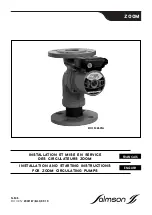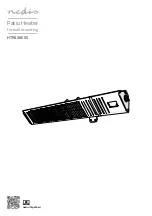
11
Maintenance
Follow the service and maintenance procedures given throughout this manual and in component literature
shipped with the water heater. Failure to perform the service and maintenance could result in damage to the
water heater or system. Failure to follow the directions in this manual and component literature could result
in severe personal injury, death, or substantial property damage.
The water heater should be inspected annually only by a qualified service technician. In addition, the
maintenance and care of the water heater designated in Table 11A and explained on the following pages must
be performed to assure maximum water heater efficiency and reliability. Failure to service and maintain the
water heater and system could result in equipment failure.
Electrical shock hazard – Turn off power to the water heater before any service operation on the water heater
except as noted otherwise in this instruction manual. Failure to turn off electrical power could result in
electrical shock, causing severe personal injury or death.
Address reported problems
1. Inspect any problems reported by the owner and correct
before proceeding.
Inspect water heater area
1. Verify that water heater area is free of any combustible
materials, gasoline and other flammable vapors and
liquids.
2. Verify that air intake area is free of any of the contaminants
listed in Section 1 of this manual. If any of these are
present in the water heater intake air vicinity, they must
be removed. If they cannot be removed, reinstall the air
and vent lines per this manual.
Inspect water heater interior
1. Remove the front access cover and inspect the interior of
the water heater.
Eliminate all system or water heater leaks.
Leaking water may cause severe property
damage.
1. Inspect all water and gas piping and verify to be leak free.
2. Look for signs of leaking lines and correct any problems
found.
3. Check gas line using the procedure found in Section 7 - Gas
Connections.
Check all piping for leaks
The condensate trap must be filled with water
during all times of water heater operation to
avoid flue gas emission from the condensate
drain line. Failure to fill the trap could result
in severe personal injury or death.
WARNING
WARNING
WARNING
WARNING
WARNING
Figure 11-1 Condensate Trap
Clean condensate trap
1. Remove the clean out cap on the bottom of the trap. Let
the condensate and any debris drain out.
2. Replace the clean out cap.
3. Fill with fresh water until the water begins to pour out of
the drain.
4. Resume
operation.
2" PVC CAP WITH
BLOCKED DRAIN SWITCH
CONDENSATE DRAIN
RETAINING SCREW
CONDENSATE FROM
HEAT EXCHANGER
REMOVABLE CAP
TO CLEAN OUT TRAP
Installation & Service Manual
TM
Flue vent system and air piping
1. Visually inspect the entire flue gas venting system and air
piping for blockage, deterioration or leakage. Repair any
joints that show signs of leakage. Verify that air inlet pipe is
connected and properly sealed.
2. Verify that water heater vent discharge and air intake are
clean and free of obstructions.
Failure to inspect for the above conditions
and have them repaired can result in severe
personal injury or death.
WARNING
Check water system
1. Verify all system components are correctly installed and
operational.
2. Check the cold fill pressure for the system. Verify it is
correct (must be a minimum of 12 PSI).
3. Watch the system pressure as the water heater heats up
(during testing) to ensure pressure does not rise too high.
Excessive pressure rise indicates expansion tank sizing or
performance problem.
4. Inspect automatic air vents and air separators. Remove air
vent caps and briefly push valve to flush vent. Replace caps.
Make sure vents do not leak. Replace any leaking vents.
58
















































